A septal defect is a hole in one of the walls dividing the chambers of the heart. Operations to correct a septal defect are a common type of pediatric heart surgery.
 Septal defects are usually congenital, meaning a person is born with it. They are the result of improper development of the heart while a baby is still in the womb. Because of this, there is no real way to prevent them, nor can they be treated by medication. Symptoms usually occur during infancy and may improve on their own or require surgery. Fortunately, many minor septal defects produce only mild symptoms and never require treatment.
Septal defects are usually congenital, meaning a person is born with it. They are the result of improper development of the heart while a baby is still in the womb. Because of this, there is no real way to prevent them, nor can they be treated by medication. Symptoms usually occur during infancy and may improve on their own or require surgery. Fortunately, many minor septal defects produce only mild symptoms and never require treatment.
Most septal defects are diagnosed before a baby is born or in early childhood. Many times they heal on their own. When septal defects require treatment, however, many options are available, ranging from minimally invasive procedures to open heart surgery.
Treatment options for septal defects
There are two types of septal defects: atrial and ventricular septal defects. Ventricular septal defects are a very common congenital cardiac anomaly and occur when there is a hole in the dividing wall between the left and right ventricles, or lower chambers of the heart. Atrial septal defects are located between the atria, the heart’s two upper chambers.
Closing a septal defect is traditionally done during childhood via open heart surgery. The surgeons create a large incision in the chest to access the heart. If the hole is small, they may be able to sew it together without using additional materials. If it is larger, they may need to use a piece of fabric or a heart tissue graft to cover the hole. Over time, heart tissue will grow over the patch and it will become a permanent part of the heart.
Minimally-inavsive procedures for septal defects
Some septal defects may now be able to be closed using minimally-invasive techniques. In this case, the medical professional will access the heart via a long, narrow tube called a catheter and use a specialized medical device to “plug” the septal defect. In this case, the physician creates a small incision in another part of the body, such as the groin or elbow, and threads the catheter through an artery or vein into the heart. Using modern medical imaging technology, the doctor is able to see what they are doing even without opening the patient’s chest, and can place the device correctly within the heart using the visuals from the imaging technology.
Patients who are first diagnosed with septal defects in adulthood can benefit from treatment in some of Germany’s top heart centers and cardio clinics, including those in the Premier Healthcare network. Treatment for children is usually performed in a children’s hospital.
At Premier Healthcare Germany, we have partnerships with several interdisciplinary heart centers and cardio clinics, as well as specialized children’s heart centers. To find out more about treatment for septal defects in Germany, contact us via our website or by phone.
